Caryn’s Thoughts
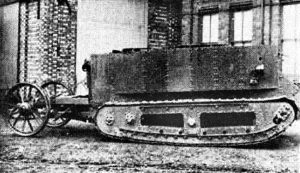 When I think of a tank, my thoughts go to an almost indestructible war machine, and I’m sure many people would agree with me. The tank was first introduced on September 6, 1915 in response to the trench warfare era of World War I. A British army colonel named Ernest Swinton and secretary of the Committee for Imperial Defense, William Hankey, championed the idea of an armored vehicle with “conveyor-belt-like tracks” over its wheels that could break through enemy lines and traverse difficult territory. It was a great idea, but the prototype tank nicknamed Little Willie manufactured in England was far from an overnight success. The tank was heavy, weighing in at 14 tons, but the big problem was that it got stuck in trenches and crawled over rough terrain at only two miles per hour. A tank isn’t much good if it has to be rescued, instead of rescuing the soldiers. It was also slow, and it became overheated and couldn’t cross the trenches. A second prototype, known as “Big Willie,” was produced. By 1916, this armored vehicle was deemed ready for battle and made its debut at the First Battle of the Somme near Courcelette, France, on September 15 of that year. Known as the Mark I, this first batch of tanks was hot, noisy and unwieldy and suffered mechanical malfunctions on the battlefield. Still, people began to realize the tank’s potential. Further design improvements were made and at the Battle of Cambrai in November 1917, 400 Mark IV’s proved much more successful than the Mark I, capturing 8,000 enemy troops and 100 guns.
When I think of a tank, my thoughts go to an almost indestructible war machine, and I’m sure many people would agree with me. The tank was first introduced on September 6, 1915 in response to the trench warfare era of World War I. A British army colonel named Ernest Swinton and secretary of the Committee for Imperial Defense, William Hankey, championed the idea of an armored vehicle with “conveyor-belt-like tracks” over its wheels that could break through enemy lines and traverse difficult territory. It was a great idea, but the prototype tank nicknamed Little Willie manufactured in England was far from an overnight success. The tank was heavy, weighing in at 14 tons, but the big problem was that it got stuck in trenches and crawled over rough terrain at only two miles per hour. A tank isn’t much good if it has to be rescued, instead of rescuing the soldiers. It was also slow, and it became overheated and couldn’t cross the trenches. A second prototype, known as “Big Willie,” was produced. By 1916, this armored vehicle was deemed ready for battle and made its debut at the First Battle of the Somme near Courcelette, France, on September 15 of that year. Known as the Mark I, this first batch of tanks was hot, noisy and unwieldy and suffered mechanical malfunctions on the battlefield. Still, people began to realize the tank’s potential. Further design improvements were made and at the Battle of Cambrai in November 1917, 400 Mark IV’s proved much more successful than the Mark I, capturing 8,000 enemy troops and 100 guns.
As with any new invention, the tank had a few “bugs” to be worked out. Still, I doubt if that did much to assuage the fears of the men in the tanks when they got stuck in the trenches. Tanks are supposed to be able to withstand gun shots and shrapnel, but would the tank be able to do so. After all, tanks weren’t supposed to get stuck either, so just how trustworthy was the armor plating. A tank that gets stuck is really just a “sitting duck.” Nevertheless, improvements were made to the original prototype and eventually tanks completely transformed military battlefields.
Trench warfare of World War I truly was brutal, almost more for the men in the trenches than anyone else. 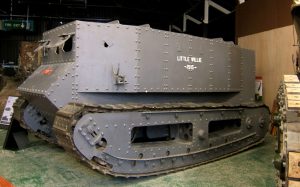 Finally, the men appealed to British navy minister Winston Churchill, who believed in the concept of a “land boat” and organized a Landships Committee to begin developing a prototype. To keep the project secret from enemies, production workers were reportedly told the vehicles they were building would be used to carry water on the battlefield…alternate theories suggest the shells of the new vehicles resembled water tanks. Either way, the new vehicles were shipped in crates labeled “tank” and the name stuck. Tanks rapidly became an important military weapon. During World War II, they played a prominent role across numerous battlefields. The tanks potential was finally an accepted fact.
Finally, the men appealed to British navy minister Winston Churchill, who believed in the concept of a “land boat” and organized a Landships Committee to begin developing a prototype. To keep the project secret from enemies, production workers were reportedly told the vehicles they were building would be used to carry water on the battlefield…alternate theories suggest the shells of the new vehicles resembled water tanks. Either way, the new vehicles were shipped in crates labeled “tank” and the name stuck. Tanks rapidly became an important military weapon. During World War II, they played a prominent role across numerous battlefields. The tanks potential was finally an accepted fact.

 My husband, Bob Schulenberg’s aunt, Pearl Hein has always felt like a kindred spirit to me. Our lives have taken some of the same turns and in many ways that makes us feel connected. Pearl spend a number of years taking care of her aging parents, and when her husband, Bob’s Uncle Ed had a stroke, Pearl stepped in again to nurse him back to health. As we both know, you can only prolong life for your loved one. Everyone dies at some point, and no matter how young or how old they are, we just aren’t ready for them to go when they do. Each of us knows that we would have continued to fight for their lives with all we had. We weren’t ready to let them go. We couldn’t understand why. Did we do something wrong? Did we miss something? We will never know, of course, but we will always have regrets…mainly the regret that they aren’t here with us anymore. Of course, we know that Heaven is far greater for all of them, but we miss them terribly, and it is so hard to move forward in our daily lives.
My husband, Bob Schulenberg’s aunt, Pearl Hein has always felt like a kindred spirit to me. Our lives have taken some of the same turns and in many ways that makes us feel connected. Pearl spend a number of years taking care of her aging parents, and when her husband, Bob’s Uncle Ed had a stroke, Pearl stepped in again to nurse him back to health. As we both know, you can only prolong life for your loved one. Everyone dies at some point, and no matter how young or how old they are, we just aren’t ready for them to go when they do. Each of us knows that we would have continued to fight for their lives with all we had. We weren’t ready to let them go. We couldn’t understand why. Did we do something wrong? Did we miss something? We will never know, of course, but we will always have regrets…mainly the regret that they aren’t here with us anymore. Of course, we know that Heaven is far greater for all of them, but we miss them terribly, and it is so hard to move forward in our daily lives.
Pearl’s dad, Merle Krueger passed away in 2002 at 97; her mom, Minnie (McCain) Krueger passed away in 2004 at 89; Uncle Ed passed way on October 16, 2019 at 76; and sadly Pearl’s son Larry passed away passed away just 3 months after his dad on January 30, 2020. It has been a really hard year for Pearl, and moving forward is not easy, but it is my hope that today, her birthday can become a new start…or at least a new normal. Pearl has always been such a loving and giving person, and she deserves to be happy too. There are so many people who love her, and I pray she will find joy in her friendships. Pearl and I have another thing in common…we are both Christians. We both believe that there is life after death, and that our loved ones are waiting for us to join them in Heaven someday.
Pearl has spent much of her life in service to others, and I know that many people are thankful to have known her. Pearl met many of her friends in the years she spent working at the IGA grocery store in Forsyth, Montana. 
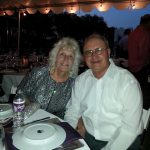 She was an indispensable employee, and when she retired to take care of Ed, they weren’t sure how they were going to function without her. I remember that whenever we would come into town, we always knew where to find Pearl, and when we went into the store, they only had to hear that we were looking for Pearl, and they were certain of who we meant. Everyone knows, and loves Pearl. She is just the kind of person you are drawn to. Today is Pearl’s birthday. Happy birthday Pearl!! Have a great day!! We love you!!
She was an indispensable employee, and when she retired to take care of Ed, they weren’t sure how they were going to function without her. I remember that whenever we would come into town, we always knew where to find Pearl, and when we went into the store, they only had to hear that we were looking for Pearl, and they were certain of who we meant. Everyone knows, and loves Pearl. She is just the kind of person you are drawn to. Today is Pearl’s birthday. Happy birthday Pearl!! Have a great day!! We love you!!
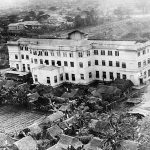
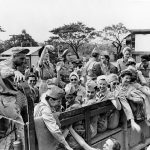 When we think of Prisoners of War during the world wars, we usually think of the prisoners as being men, but there were women too…nurses. At that time, women couldn’t be in combat positions, and if they wanted to serve their country, it had to be as nurses or medics. One group of United States Army Nurse Corps and United States Navy Nurse Corps nurses, were stationed in the Philippines at the outset of the Pacific War, were later dubbed the Angels of Bataan (also including the the nurses of the island of Corregidor), were also called the Angels of Bataan and Corregidor and the Battling Belles of Bataan. The 78 nurses served during the Battle of the Philippines (1941–42). When Bataan and Corregidor fell, 11 Navy nurses, 66 army nurses, and 1 nurse-anesthetist were captured and imprisoned in and around Manila. These loyal, patriotic women continued to serve as a nursing unit while prisoners of war, taking care of their fellow prisoners, even if it meant punishment for their actions.
When we think of Prisoners of War during the world wars, we usually think of the prisoners as being men, but there were women too…nurses. At that time, women couldn’t be in combat positions, and if they wanted to serve their country, it had to be as nurses or medics. One group of United States Army Nurse Corps and United States Navy Nurse Corps nurses, were stationed in the Philippines at the outset of the Pacific War, were later dubbed the Angels of Bataan (also including the the nurses of the island of Corregidor), were also called the Angels of Bataan and Corregidor and the Battling Belles of Bataan. The 78 nurses served during the Battle of the Philippines (1941–42). When Bataan and Corregidor fell, 11 Navy nurses, 66 army nurses, and 1 nurse-anesthetist were captured and imprisoned in and around Manila. These loyal, patriotic women continued to serve as a nursing unit while prisoners of war, taking care of their fellow prisoners, even if it meant punishment for their actions.
After the attack on Pearl Harbor, the Japanese immediately went after the Philippines and the military personnel based there, including the nurses. In late December 1941, many of the nurses were assigned to a pair of battlefield hospitals on Bataan named Hospital #1 and Hospital #2. These hospitals included the first open-air wards since the Civil War. Tropical diseases, including malaria and dysentery, were widespread among both hospital patient and staff. Just prior to the fall of Bataan on April 9, 1942, the nurses serving there were ordered to the island fortress of Corregidor by General Wainwright (commander of the forces in the Philippines after MacArthur was ordered to Australia). Wainwright tried to save as many people as he could by moving them to the safer island of Corregidor. In the end it made no difference, because Corregidor was captured too.
During their occupation of the Philippines, the Japanese commandeered the campus of the University of Santo Tomas and converted it to be the Santo Tomas Internment Camp. In addition to its civilian population, Santo Tomas became the initial internment camp for both the army and navy nurses, with the army nurses remaining there until their liberation, while the soldiers were taken on the Bataan Death March. While there, the nurses continued to take care of anyone they were allowed to. Under the supervision of Captain Maude C Davison, a 57 year old nurse, with 20 years of service experience, the nurses continued to do their jobs. Davison took command of the nurses, maintained a regular schedule of nursing duty, and insisted that all nurses wear their khaki blouses and skirts while on duty.
The number of internees at Santo Tomas Internment Center in February 1942 amounted to approximately 4,670 people, of whom 3,200 Americans. Of those 3,200 Americans, 78 were nurses. The Americans, anticipating the war, had sent many wives and children of American men employed in the Philippines to the states before December 8, 1941. A few people had been sent to the Philippines from China to escape the war in that country. Some had arrived only days before the Japanese attack. The prisoners were crowded 30 to 50 people per small classrooms in university buildings. The allotment of space for each individual was 16 to 22 square feet. Bathrooms were scarce. Twelve hundred men living in the main building had 13 toilets and 12 showers. Lines were normal for toilets and meals. Internees with money were able to buy food and built huts, “shanties,” of bamboo and palm fronds in open ground where they could take refuge during the day, although the Japanese insisted that all internees sleep in their assigned rooms at night. Soon there were several hundred shanties and their owners constituted a “camp aristocracy.” The Japanese attempted to enforce a ban on sex, marriage, and displays of affection among the internees. They often complained to the Executive Committee about “inappropriate” relations between men and women in the shanties.
The conditions at Santo Tomas were horrific. The biggest problem for the internees was sanitation, followed closely by starvation. The Sanitation and Health Committee had more than 600 internee men working for it. Their tasks included building more toilets and showers, laundry, dishwashing, and cooking facilities, disposal of garbage, and controlling the flies, mosquitoes, and rats that infested the compound. Then, in January 1944, control of the Santo Tomas Internment Camp changed from Japanese civil authorities to the Imperial Japanese Army, with whom it remained until the camp was liberated. Food, which had been scarce before, was reduced to only 960 calories per person per day by November 1944, and then to 700 calories per person per day by  January 1945. At the time the nurses were finally released, it was found that they had lost, on average, 30% of their body weight during internment, and subsequently experienced a degree of service-connected disability “virtually the same as the male ex-POW’s of the Pacific Theater.” Davison’s body weight dropped from 156 pounds to 80 pounds.
January 1945. At the time the nurses were finally released, it was found that they had lost, on average, 30% of their body weight during internment, and subsequently experienced a degree of service-connected disability “virtually the same as the male ex-POW’s of the Pacific Theater.” Davison’s body weight dropped from 156 pounds to 80 pounds.
Finally, General Douglas MacArthur, emboldened by the success of the Raid at Cabanatuan, ordered Major General Vernon D Mudge to make an aggressive raid on Santo Tomas in the Battle of Manila in 1945. The internees at Santo Tomas, including the nurses, were liberated on February 3, 1945, by a “flying column” of the 1st Cavalry.

 My son-in-law, Kevin Petersen is a car fanatic. He loves classic cars, and knows just how to make them shine. From the engine to the paint job, Kevin has the skills. His dad, Dean Petersen gave Kevin his 1966 Mercury Cyclone, and Kevin is slowly restoring it. Unfortunately with his rheumatoid arthritis, he can only work about an hour a day a few days a week. Still, he is getting there. Kevin rents a shop where he stores his car and his son, my grandson, Chris’ Camaro. When Kevin gets his car done, it will be stunning. Kevin has always had nice cars, usually classics. This was something Kevin shared with his boys, Chris and Josh. Its a guy thing. I don’t know many guys who don’t love cars.
My son-in-law, Kevin Petersen is a car fanatic. He loves classic cars, and knows just how to make them shine. From the engine to the paint job, Kevin has the skills. His dad, Dean Petersen gave Kevin his 1966 Mercury Cyclone, and Kevin is slowly restoring it. Unfortunately with his rheumatoid arthritis, he can only work about an hour a day a few days a week. Still, he is getting there. Kevin rents a shop where he stores his car and his son, my grandson, Chris’ Camaro. When Kevin gets his car done, it will be stunning. Kevin has always had nice cars, usually classics. This was something Kevin shared with his boys, Chris and Josh. Its a guy thing. I don’t know many guys who don’t love cars.
As his boys have grown up…Chris is 24 and Josh will be 22 on the 9th of this month…they don’t have as much time to spend with their parents. They still try to help and visit their dad and mom whenever they can, but they 
 work a lot of hours, and Chris has a family too. Of course, that is a blessing in itself. Being a grandpa has been the most wonderful thing too. Kevin has always been all about his family. His granddaughter and soon, new grandson, have him literally bursting with joy. Babies have a way of doing that. Now, as in many families, the grandparents go to visit the grandkids, at least more than the kids get to their house. The work around Chris’ schedule, but they don’t mind. They also like to FaceTime with their granddaughter, who immediately commandeers her parents’ phones to take her grandparents to her room to watch her play. Mostly she’s pretty good about keeping the conversation going, and not just getting absorbed in her play, but even if she does that, they don’t really mind. They love watching her play. She has become a great big part of their world.
work a lot of hours, and Chris has a family too. Of course, that is a blessing in itself. Being a grandpa has been the most wonderful thing too. Kevin has always been all about his family. His granddaughter and soon, new grandson, have him literally bursting with joy. Babies have a way of doing that. Now, as in many families, the grandparents go to visit the grandkids, at least more than the kids get to their house. The work around Chris’ schedule, but they don’t mind. They also like to FaceTime with their granddaughter, who immediately commandeers her parents’ phones to take her grandparents to her room to watch her play. Mostly she’s pretty good about keeping the conversation going, and not just getting absorbed in her play, but even if she does that, they don’t really mind. They love watching her play. She has become a great big part of their world.

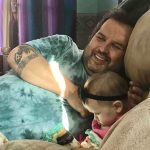 Kevin has always had a soft heart, but he is fiercely loyal to his family and will defend them to the end. He is always there to help whenever he can, and he is a great husband and dad. Kevin is an artist. His work is beautiful, and I love that I have been the recipient of some of his work. He has done beautiful stained glass work, paintings, and drawings. Not everyone has that ability, and so it’s awesome that my son-in-law is one that did. His disability has limited the amount of art he can do, but what he does is wonderful. Today is Kevin’s birthday. Happy birthday Kevin!! Have a great day!! We love you!!
Kevin has always had a soft heart, but he is fiercely loyal to his family and will defend them to the end. He is always there to help whenever he can, and he is a great husband and dad. Kevin is an artist. His work is beautiful, and I love that I have been the recipient of some of his work. He has done beautiful stained glass work, paintings, and drawings. Not everyone has that ability, and so it’s awesome that my son-in-law is one that did. His disability has limited the amount of art he can do, but what he does is wonderful. Today is Kevin’s birthday. Happy birthday Kevin!! Have a great day!! We love you!!
 It is common knowledge that many presidents served in the military, but for some reason, many people don’t think about the fact that, had things gone differently, that person would not have been our president. Such is the case with George HW Bush, who was a torpedo bomber pilot, stationed in the Pacific Theater of World War II. On September 2, 1944, the future President George HW Bush was on a mission when his plane was hit by Japanese anti-aircraft guns. The damage was sufficient enough that the crew had no choice but to bail out of the plane over the ocean.
It is common knowledge that many presidents served in the military, but for some reason, many people don’t think about the fact that, had things gone differently, that person would not have been our president. Such is the case with George HW Bush, who was a torpedo bomber pilot, stationed in the Pacific Theater of World War II. On September 2, 1944, the future President George HW Bush was on a mission when his plane was hit by Japanese anti-aircraft guns. The damage was sufficient enough that the crew had no choice but to bail out of the plane over the ocean.
According to the Navy’s records, Bush’s squadron was conducting a bombing mission on a Japanese installation on the island of Chi Chi Jima in the Pacific when they encountered heavy anti-aircraft fire. The engine on Bush’s plane was set ablaze, yet Bush managed to release his bombs and head back toward the aircraft carrier San Jacinto before bailing out over the water. Two other crew members perished in the attack. After floating on a raft for four hours, a submarine crew fished a safe but 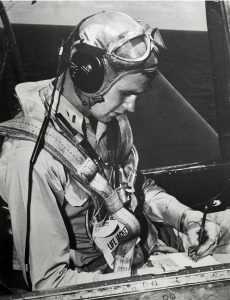 exhausted Bush out of the water. Bush was given the Distinguished Flying Cross. This was not the only close call Bush had. After making a previous bombing run, he was forced to make a crash landing on water. He was rescued by a US destroyer crew on that mission. After his experience near Chi Chi Jima, Bush returned to the San Jacinto and continued to pilot torpedo bombers in several successful missions.
exhausted Bush out of the water. Bush was given the Distinguished Flying Cross. This was not the only close call Bush had. After making a previous bombing run, he was forced to make a crash landing on water. He was rescued by a US destroyer crew on that mission. After his experience near Chi Chi Jima, Bush returned to the San Jacinto and continued to pilot torpedo bombers in several successful missions.
Throughout 1944, the squadron, VT-51, of which Bush was a part, suffered a 300% casualty rate among its pilots. The squadron was based off of the USS San Jacinto, and somehow, the future president managed to win three Air Medals, as well as a Presidential Unit Citation. Over the course of his military career, Bush flew 58 combat missions during the war, and achieved the rank of lieutenant. Following his time in the South Pacific, Bush was reassigned to Norfolk Naval Base in Norfolk, Virginia in December of 1944. There he was tasked with training new pilots. He received an honorable discharge from the Navy in September 1945 after the Japanese surrender.

Thinking of a president as having come so close to death, and the complete change of history that his death would have brought to the United States, is an odd thought, but it was entirely possible, nevertheless. While we would not have realized the difference it would make, because we wouldn’t have know what was to be. Still, good or bad, for better or worse…it would have changed history. In this case, President George HW Bush did survive, and even continued to parachute out of planes. No one ever said exactly why he did that, but maybe it was to celebrate his bailout. Nevertheless…every 5th birthday, even on his 90th, when he was confined to a wheelchair, President Bush strapped on a parachute and bailed out of a plane. Not my idea of fun, but then I have no desire to jump out of a perfectly goo airplane. Still, there are a lot of people, including my son-in-law, Travis Royce and grandson, Caalab Royce, who think it’s a great idea. President Bush passed away on November 30, 2018 at the good old age of 94.
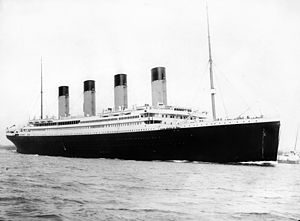 On September 1, 1985 a ship that had been missing in the North Atlantic since 1912…the RMS Titanic…was finally located, but the way in which it was found was not what it seemed to be. Everyone knows the story of Titanic, either from personal loss, history, or from recent movies on the subject, that romanticized it and endeared the ship to the world. The Titanic sank on April 15, 1912, after sailing headlong into an iceberg, while traveling at an unsafe speed, against protocol. The disaster took 1500 people to a watery grave, and changed the protocols concerning the radio room, speeds in iceberg prone areas, and radar to warn the ships about obstacles in the area.
On September 1, 1985 a ship that had been missing in the North Atlantic since 1912…the RMS Titanic…was finally located, but the way in which it was found was not what it seemed to be. Everyone knows the story of Titanic, either from personal loss, history, or from recent movies on the subject, that romanticized it and endeared the ship to the world. The Titanic sank on April 15, 1912, after sailing headlong into an iceberg, while traveling at an unsafe speed, against protocol. The disaster took 1500 people to a watery grave, and changed the protocols concerning the radio room, speeds in iceberg prone areas, and radar to warn the ships about obstacles in the area.
Oceanographer, Robert Ballard successfully found the Titanic while on a scientific mission for, of all people, the US Navy. The Navy had no interest in the Titanic, but Ballard had long wanted to find it, and he decided that the current mission would be the perfect chance to hunt for the Titanic, as well as the two submarines, USS Thresher and USS Scorpion, both of which had gone down in the North Atlantic and both of which were carrying powerful nuclear reactors. The Navy wanted to know if the Soviets had 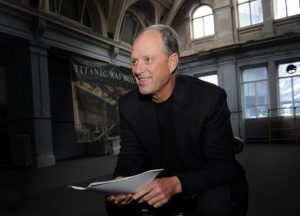 shot down the submarined and if their nuclear material still remained 15,000 feet beneath the surface.
shot down the submarined and if their nuclear material still remained 15,000 feet beneath the surface.
Ballard asked the Navy to fund a project called Argo in the early 1980s. Argo was a submarine that could photograph the underwater to a depth of 20,000 feet. He wanted to find Titanic, but the Navy wanted to us the Argo to find the Thresher and the Scorpion. They agreed provided that he search for all three. In 1985 Ballard set out on a covert Cold War Mission, but publicly he was looking for Titanic. Ballard found the USS Scorpion, and then had just 12 days left to find Titanic. It was not going to be easy. Twelve days to find a ship that the French Research Institute couldn’t locate in five weeks.
While it seemed unlikely that the team would find the Titanic in the short amount of time they had left, their worry about the project’s success would prove unfounded. Around 2am on September 1, 1985, after over a week of taking pictures and finding nothing, the on-duty watch team called for Ballard. The Argo had spotted 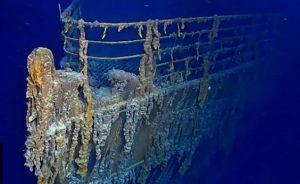 something unusual on the seafloor. As the team peered at a grainy image before realizing that they were looking at the boiler from the Titanic. The team was ecstatic, as the popped champagne for a toast. Then they realized that it was almost the exact time that Titanic went down 73 years earlier. The team felt almost as if they were violating the sanctity of a grave, even if it was well below them. Ballard later wrote, “It was one thing to have won – to have found the ship. It was another thing to be there. That was the spooky part. I could see the Titanic as she slipped nose first into the glassy water. Around me were the ghostly shapes of the lifeboats and the piercing shouts and screams of people freezing to death in the water.”
something unusual on the seafloor. As the team peered at a grainy image before realizing that they were looking at the boiler from the Titanic. The team was ecstatic, as the popped champagne for a toast. Then they realized that it was almost the exact time that Titanic went down 73 years earlier. The team felt almost as if they were violating the sanctity of a grave, even if it was well below them. Ballard later wrote, “It was one thing to have won – to have found the ship. It was another thing to be there. That was the spooky part. I could see the Titanic as she slipped nose first into the glassy water. Around me were the ghostly shapes of the lifeboats and the piercing shouts and screams of people freezing to death in the water.”
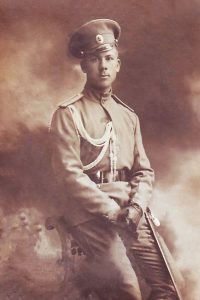
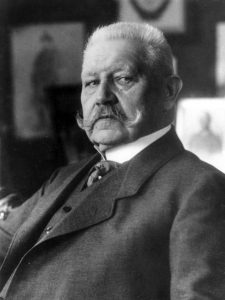 In what might today be considered almost post-apocalyptic, the Battle of the Osowiec Fortress, was nevertheless fought during World War I. The year was 1915, and World War I was in full swing. It was also an era of innovation in weaponry, and many were the never-before-seen weapons of warfare, as well as new and never-before-heard-of tactics.
In what might today be considered almost post-apocalyptic, the Battle of the Osowiec Fortress, was nevertheless fought during World War I. The year was 1915, and World War I was in full swing. It was also an era of innovation in weaponry, and many were the never-before-seen weapons of warfare, as well as new and never-before-heard-of tactics.
The Germans had launched a full frontal attack on the Russian Osowiec Fortress, located in present-day Poland, at the beginning of July. Included in the attack were 14 battalions of infantry, one battalion of sappers, 24–30 heavy siege guns, and 30 batteries of artillery equipped with poison gasses led by Field Marshal Paul von Hindenburg. Russian defenses were manned by 500 soldiers of the 226th Infantry Regiment Zemlyansky, and 400 militia. The Russians were quite outnumbered.
On August 6, 1915, the German forces employed chemical weapons on the Russians. At 4am, after waiting for favorable wind conditions, the German attack began with regular artillery bombardment combined with chlorine gas. As the scene was described, “The gas caused the grass to turn black and leaves to turn yellow, and the dead birds, frogs, and other animals and insects were lying everywhere. Terrain looked like Hell.” The Russians soldiers either had no gas masks, or had only poorly made ones, and most soldiers used their undershirts as masks, with many soaking them in water or urine to help with their effectiveness at holding the gas at bay. I think most of us have heard of the horrors caused by the use of chemical warfare, and most people are vehemently opposed to such atrocity, because of the effects, which if not instantly deadly, can cause the victim to slowly die over a number of years, fraught with lingering health problems. Most of the Russian soldiers died immediately, but some survived the gas attack. Sub-Lieutenant Vladimir Kotlinsky, the highest ranking Russian soldier to survive the initial attack, rallied the other surviving soldiers. They decided to charge the advancing German lines…what choice did they really have.
Over twelve battalions of the 11th Landwehr Division, making up more than 7000 men, advanced after the bombardment expecting little resistance. They were met at the first defense line by a counter-charge made up of the surviving soldiers of the 13th Company of the 226th Infantry Regiment. The invading German forces were horrified when they saw what appeared to be zombie-like soldiers. The panic began when they first caught sight of the Russians, who were coughing up blood and bits of their own lungs, as the hydrochloric acid formed by the mix of the chlorine gas and the moisture in their lungs had begun to dissolve their flesh. The Russian men were covered in blisters and coughing up their own respiratory organs, the Germans were subsequently retreating. The Russian garrison suffered heavy losses, but some soldiers survived even after the final charge, and Chlorine gas barrage. The Germans had retreated so fast that they got caught up in their own c-wire traps. The five remaining Russian guns subsequently opened fire on the fleeing Germans. Kotlinsky died later that evening. The Russian soldiers had basically fought their last battle as they were dying…hence the name given to the battle…The Attack of the Dead Men.
The dying Russians could not hold the area for much longer, of course. The soldiers there were sick, dying, or already dead. The Germans threatened to encircle the fortress with the capture of Kaunas and Novogeorgiesk. Knowing their fort was lost, the Russians demolished much of the fortress and withdrew on August 18th. While 
 the German casualties were moderate to heavy, they were not nearly as bad as the Russian casualties of about 800 of the 900 men that were deployed at the fort. This story, although virtually unknown to the outside world, is a symbol of Russian military power and courage under fire. The story of this battle is commonly told and taught in Russian history classes.
the German casualties were moderate to heavy, they were not nearly as bad as the Russian casualties of about 800 of the 900 men that were deployed at the fort. This story, although virtually unknown to the outside world, is a symbol of Russian military power and courage under fire. The story of this battle is commonly told and taught in Russian history classes.
 In the Soviet Union’s Catherine Palace, located near Saint Petersburg, is rumored to have been a beautiful chamber decorated in amber panels backed with gold leaf and mirrors. The elaborately designed hall was a gift to Peter the Great from Germany. Constructed in the 18th century in Prussia, the room was dismantled and eventually disappeared during World War II. In the days before World War II started, Hitler had worked an “alliance agreement” with Stalin. Hitler really had no intention of keeping the agreement, but rather wanted to take control of Poland without Soviet interference. That didn’t make the Soviet Union safe either. When Germany made their move, the Soviets did not have enough time to prepare.
In the Soviet Union’s Catherine Palace, located near Saint Petersburg, is rumored to have been a beautiful chamber decorated in amber panels backed with gold leaf and mirrors. The elaborately designed hall was a gift to Peter the Great from Germany. Constructed in the 18th century in Prussia, the room was dismantled and eventually disappeared during World War II. In the days before World War II started, Hitler had worked an “alliance agreement” with Stalin. Hitler really had no intention of keeping the agreement, but rather wanted to take control of Poland without Soviet interference. That didn’t make the Soviet Union safe either. When Germany made their move, the Soviets did not have enough time to prepare.
It was 1941, when the Germans advanced. The job of removing the panels to safety would take time…time they didn’t have. The panels were quickly taken by the Germans and transported to Konigsberg, East Prussia. They were confiscating anything of value. Initially, the Amber Room was placed on public display at the Konigsberg Castle, but was hidden in anticipation of the 1945 Soviet advance. Before its loss, it was considered an “Eighth Wonder of the World.”
In 1701, the Amber Room was intended for the Charlottenburg Palace, in Berlin, Prussia, but was eventually installed at the Berlin City Palace. Designed by German baroque sculptor Andreas Schlüter and Danish amber craftsman Gottfried Wolfram, who worked on the room until 1707, at which time the work was continued by amber masters Gottfried Turau and Ernst Schacht from Danzig (Gdansk). The masterpiece remained in Berlin until 1716, when it was given by the Prussian King Frederick William I to his ally Tsar Peter the Great of the Russian Empire. In Russia, the beautiful room was installed in the Catherine Palace. In the castle, the room was further expanded and several renovations where performed, making it an even more stunning chamber than it had been before. In the end, it covered more than 590 square feet and contained over 13,000 pounds of amber.
When the Army Group North of Nazi Germany took possession of the Amber Room during World War II, it was taken to Königsberg for reconstruction and display. Like many stolen treasures, the Germans hid the Amber Rooms panels, and its eventual fate and current whereabouts, if it has survived, remain a mystery. While most 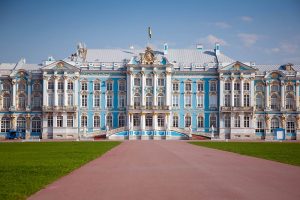 experts believed it was obliterated during the intense shelling that destroyed the Konigsberg Castle, I don’t believe that is true, because surely some evidence of that much amber would have been found after a bombing, but none was ever found at the site.
experts believed it was obliterated during the intense shelling that destroyed the Konigsberg Castle, I don’t believe that is true, because surely some evidence of that much amber would have been found after a bombing, but none was ever found at the site.
Persistent rumors about the current location of the Amber Room have never panned out, and after years of searching, it was decided in 1979, to create a reconstructed Amber Room at the Catherine Palace. After decades of work by Russian craftsmen and donations from Germany, the reconstructed Amber Room was finally inaugurated in 2003.
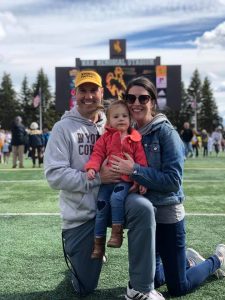
 Like she had in the past, my niece, Lindsay Moore is working for South Dakota State University. She if the director of HOP…the Health and Obesity Program. Lindsay’s degree is in Kinesiology, which is the science of the movement of the body, so it is a perfect position for her, and since they are perfectly fine with her working from home, it is a perfect position for Lindsay, who loves being able to stay at home with her daughter Mackenzie.
Like she had in the past, my niece, Lindsay Moore is working for South Dakota State University. She if the director of HOP…the Health and Obesity Program. Lindsay’s degree is in Kinesiology, which is the science of the movement of the body, so it is a perfect position for her, and since they are perfectly fine with her working from home, it is a perfect position for Lindsay, who loves being able to stay at home with her daughter Mackenzie.
Mackenzie is now sleeping in her own room, which Lindsay and her husband, Shannon have turned into a sweet little girl room for her…complete with a polka-dot accent wall. Mackenzie loves everything about the room her parents created for her…when the family isn’t camping that is. This year, Covid-19 abruptly ended the school year for many, and the University of Wyoming was no exception. Shannon was suddenly at home with his family, and it was the greatest treasure Lindsay can imagine. It allowed trips to visit her parents, Allyn and Chris Hadlock in Casper, and his parents TJ and Mary Jo Moore. They also enjoyed having family members come to Laramie for visits. Once the campgrounds reopened, they did a lot of camping…mostly because they love it, but also to fend off cabin fever.
As happens with growing families, the Hadlock clan decided to do a group birthday party for Adelaide Sawdon, Aurora Hadlock, Lindsay Moore, and Mackenzie Moore. The party was a big success, culminating in a outdoor movie, utilizing a projector that Jessie Sawdon was able to borrow for the festivities. Everyone had a great time. Outdoor movies always were fun.
Lindsay has especially enjoyed having Shannon home so often, as it truly has been a gift. He got to spoil his girls, and Mackenzie became even more a “daddy’s girl,” than she was before. She and Lindsay always had a great bond, because of the time they spent together, but prior to this period, Shannon didn’t have the same kind of time to spend with their girl. It was a rare blessing, that will likely never happen again, and they made sure they treasured every moment of it. The added time also gave Lindsay and Shannon time to really enjoy being together. They worked on projects on the house, and spent time making plans for whatever future changes they will make.
This year was a unique year, and one that we really can’t expect to happen again. Covid-19 will pass into 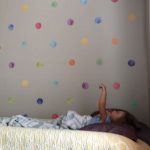
 history, and the Pokes of the University of Wyoming will resume their football seasons again. Shannon will go back to work full time, and Lindsay will continue her work at SDSU. Before long, Mackenzie will be in school too. Time flies so fast. They will most likely never have such a sweet gift of time, in which they can relax and just enjoy being together, but they will always treasure the gift of time they were given. Today is Lindsay’s birthday. Happy birthday Lindsay!! Have a great day!! We love you!!
history, and the Pokes of the University of Wyoming will resume their football seasons again. Shannon will go back to work full time, and Lindsay will continue her work at SDSU. Before long, Mackenzie will be in school too. Time flies so fast. They will most likely never have such a sweet gift of time, in which they can relax and just enjoy being together, but they will always treasure the gift of time they were given. Today is Lindsay’s birthday. Happy birthday Lindsay!! Have a great day!! We love you!!

 My father-in-law, Walt Schulenberg was a hard working, but gentle and loving man. His family was everything to him. His job often took out of town on road construction. He was often gone for long periods of time on jobs. My father-in-law, Walt Schulenberg was a hard working, but gentle and loving man. His family was everything to him. His job often took out of town on road construction. He was often gone for long periods of time on jobs. When they could, the family would go along, such as the summer the company was working in Point of Rocks, Wyoming. For those who don’t know it, there is nothing to do in Point of Rocks. It is a small town in Sweetwater county that sports a permanent population of three. During the year there are many temporary residents throughout the year, but that does not count in the census.
My father-in-law, Walt Schulenberg was a hard working, but gentle and loving man. His family was everything to him. His job often took out of town on road construction. He was often gone for long periods of time on jobs. My father-in-law, Walt Schulenberg was a hard working, but gentle and loving man. His family was everything to him. His job often took out of town on road construction. He was often gone for long periods of time on jobs. When they could, the family would go along, such as the summer the company was working in Point of Rocks, Wyoming. For those who don’t know it, there is nothing to do in Point of Rocks. It is a small town in Sweetwater county that sports a permanent population of three. During the year there are many temporary residents throughout the year, but that does not count in the census.
During the summer that my husband, Bob’s family lived there while my father-in-law worked in the area, Bob was a bored kid. Here he was living in Podunk, with nothing to do, and mostly just his sisters and a couple of other kids to hang out with. There was a highlight to the day…when the trains came through. The trains were on the opposite side of the interstate, so it was safe for Bob to run down the street and count the cars on the train. It was a pathetic attempt at fun, but the reward was great…the family got to see his dad every day, and not just on weekends for one day. It was worth it to all of them.
My father-in-law had made the decision to be with the family as much as he possibly could. I’m not sure if his decision was before or after another incident I had heard of. When my sister-in-law, Brenda was about six months old, my father-in-law was out of town a lot. He came home on the weekends, and sometimes not even that often. It was hard on the family, but they were making due…most of them anyway. Brenda was a happy baby, and was known to laugh and smile at her family all the time. One particular weekend, my father-in-law 
 came home, and Brenda took one look at him and started screaming and crying. It was at about the time when babies start to dislike strangers, but that didn’t matter to my father-in-law. He just knew he shouldn’t be a stranger to his own child. Nevertheless, Brenda didn’t stop crying until he left to go back to work. As for my father-in-law…he went back to wok and gave his notice. He knew he could find another job, but he refused to see his little girl upset, because she didn’t know her daddy. He made sure that he worked where he could be home at night, even if he had to go to work ar 3:00 in the morning in order to be home in the evening. He was always a dad first. Today would have been my father-in-law’s 91st birthday. Happy birthday in Heaven, Dad. We love and miss you very much.
came home, and Brenda took one look at him and started screaming and crying. It was at about the time when babies start to dislike strangers, but that didn’t matter to my father-in-law. He just knew he shouldn’t be a stranger to his own child. Nevertheless, Brenda didn’t stop crying until he left to go back to work. As for my father-in-law…he went back to wok and gave his notice. He knew he could find another job, but he refused to see his little girl upset, because she didn’t know her daddy. He made sure that he worked where he could be home at night, even if he had to go to work ar 3:00 in the morning in order to be home in the evening. He was always a dad first. Today would have been my father-in-law’s 91st birthday. Happy birthday in Heaven, Dad. We love and miss you very much.

